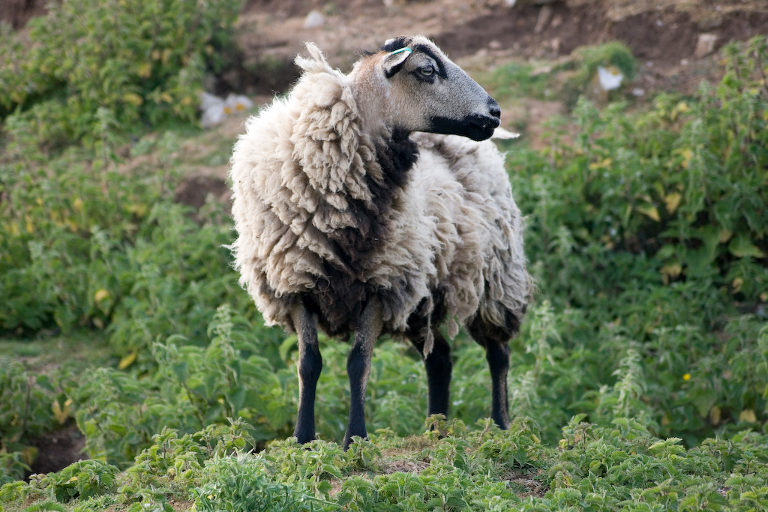Continuing my amble through my book A Small Farm Future, my next stop in Part I is Crisis #7 – Land (pp.43-51). There’s a specific aspect of this that’s topical at the moment here in the UK, so I’ll begin with that and work my way towards a more general conclusion that’s implicit in the book.
With a no deal Brexit looming and the Government’s farm subsidy regimen shifting towards payments only for delivering ‘public goods’, it looks like hard times may lie ahead for many commercial farmers in the UK, none more so than for upland livestock farmers. The UK is by far the EU’s largest sheep producer, and about a third of its production is exported, the great majority to other EU countries. So sheep farmers (primarily in the uplands) face a double blow of contracting markets and contracting farm support. I’m not sure exactly how that will play out, but maybe with farmers shooting a lot of next year’s lambs. I hope none of them end up shooting themselves.
The decline of the upland livestock industry will be celebrated by many in the (re)wilding movement, for whom Britain’s ‘sheepwrecked’ mountains have become the iconic example of misplaced agrarianism at the expense of wilderness. Without the intensive grazing pressure of sheep, the argument goes, the mountains would regain their tree cover, with numerous benefits for biodiversity, as well as lowland flood abatement. And instead of eking out a marginal economic existence as farmers, the people of the uplands could then earn better rewards as custodians of the rejuvenating wilderness and workers in the consequently growing tourist industry.
The rewilders surely have a point. Sheep stocking in the uplands is at a high level historically and there’s much to be said for reducing it and creating more complex silvopastoral upland landscapes. Arguably, this would more closely resemble the farmed upland landscapes of the past, when the mountain valleys would also have had a greater diversity of arable farming, horticulture and local crafts and industries, much of it devoted to local needs. What changed was less an enthusiasm among upland farmers to cram the hills with sheep than the dictates of central government policy, in the UK as in many other countries, which has generally pushed farmers to focus upon the single most advantageous and remunerative crop in their area to the exclusion of almost everything else. There’s a danger that by design or default (re)wilding will figure as another top-down policy prescription imposed from afar, without connecting to local histories of mixed land use geared to feeding people locally.
This touches on debates about so-called ‘land sparing’ versus ‘land sharing’ that I discuss under Crisis #7 in the book. Behind them lies a wider philosophical question of human ecology: which is preferable, a world of domesticated and urbanized humans experiencing unpeopled wilderness only as visitors and sojourners, or a world of rather wilder humans making modest livelihoods in rural spaces? And perhaps behind them too lies a matter of practical ecology sparked by the classic ecological question of why the world is green – that is, are plant-rich terrestrial landscapes preserved from the depredations of herbivorous animals top-down by predator control of the herbivores, or bottom-up by plant defences against herbivory?
I won’t dwell on all that here, but essentially I’m in the bottom-up camp. Share land, wild ourselves by learning to live in place, and don’t over-fetishise predators because plants can more or less take care of themselves. Still, in the short term I daresay that erstwhile farmers in the uplands will make a better living working as tour guides than they ever did as shepherds. In the present economy, herding people always pays better than herding livestock. But while they might be making a better living – and while some, I’m sure, will genuinely take to tourist work – I’m not convinced that many upland folks will be making a better livelihood, in the sense of participating in a way of life that’s deeply structured to the sustaining possibilities of the local landscape. And this, ultimately, is what seems most likely to endure. The present collapse of tourism due to Covid-19 is surely only the harbinger of a larger and longer collapse in the possibility that the wider economy can keep infusing places with wealth greatly beyond their local means.
For sure, people gain from participating in the wider economy and the services it provides. Doubtless there are few who would want to renounce all of it in what Emma Marris (who I quote on p.27 of my book) calls the ‘grand sacrifices’ involved in turning our backs on our contemporary high-energy, high-throughput society. But that society isn’t quite as paradisiacal as is often supposed, especially for those with a less advantageous place within it. And, however paradisiacal it is, it’s in any case unlikely to survive the numerous crises that I outline in Part I of my book.
Therefore, I think many of us certainly will need to make sacrifices. So perhaps it’s as well for us to ‘sacrifice’ in the original sense of the word – to make sacred. An awful lot of contemporary thought makes sacred urban, fluid, high-energy consumer culture. It’s time to put this romanticism aside. We now need to find ways to come to terms with both the opportunities and the constraints within local agroecosystems like the forgotten silvo-arable-pastoral systems of upland Britain, thereby making them sacred.
But with the sacred comes the profane. So we also need to think through the difficulties of small farm localism, just as the romantics of urban modernity need to think through the difficulties of their own vision. As to whether continuing with present high-energy, urbanizing, monoculturalizing trends involves more sacrifice than low-energy, decentralizing, landscape diversifying trends, it really depends on what you consider to be sacred.
Teaser photo credit: By Sam Sam – BadgerFace, CC BY 2.0, https://commons.wikimedia.org/w/index.php?curid=11094010






